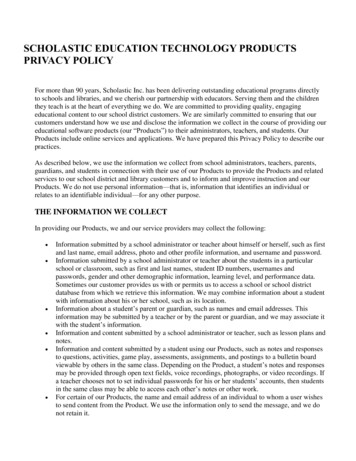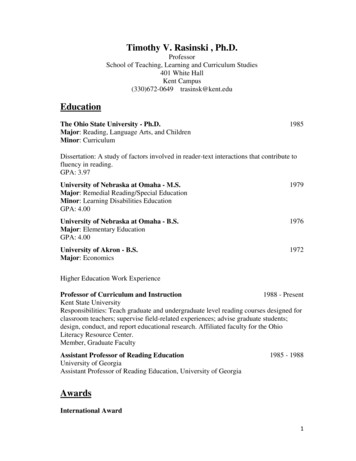
Transcription
Vol. 22 No. 1 ISSN 1068-0292SEPTEMBER or quizzes and activities, go to storyworks.scholastic.com.
Welcome towhere books come to life!SEPTEMBER 2014Nonfction4The Volcano ThatChanged the Worldby Lauren TarshisPaired Texts10 Talen’s Got Talent!by Jane BianchiFiction15 Silverman Cityby Jenny NimmoPoetry21 A Punctuation StoryGramThese animals look adorable. But don’t befooled—they’re very dangerous! Find out moreabout them as you help Grammar Cop correctsome deadly capitalization errors.WHAT TO DO:1. Read each animal’s important rule about capitalization.2. Use each animal’s rule to help you fx the errors in itsdescription.by Rebecca Kai DotlichPlay22 Pandora’s Boxby Jennifer DignanDebate28 Should Parents Help KidsWith Homework?Infographic32 Your Very Own Pet Rat!Plus:2 Grammar Cop14 Create a Character ContestWendy Mass!30 Vocab Lab One Word, 3 Ways;Word NerdMY RULECapitalize namesof places andadjectives madefrom them—likeAmerica andAmerican.Cover illustration by Susan FarringtonWRITE TO US!(Name of contest or department)c/o StoryworksP.O. Box 712New York, NY 10013-0712Or e-mail contest entries to:storyworks@scholastic.com(Please put contest name in subject line.)Students, remember to include your1) name and age2) teacher’s name3) school’s name4) school’s address5) school’s phone number2S T O R Y W O R K SSlow LorisThis mammal lives in rainforests in india, china, andother asian countries. It looks sweet and cuddly. But ifit’s threatened, it’ll release a fluid from a gland in its arm.It licks the fluid, which mixes with saliva to make its bitepoisonous. Yeesh! You’ll want to run to antarctica!
mmar CopCAPITALWORDSIZECORRECTLYPolar BearPolar bears might seemlovable in books like thegolden compass. Theymight wow you in nationalgeographic. But in a fewyears, this cute cub willstand more than 8 feettall and will have paws asbig as your head. Maybeit deserves to be inguinness worldrecords.MY RULECapitalize thefirst, last, andother importantwords in a title.MY RULEThe first wordinside quotationmarks should becapitalized.THOMAS MARENT/MINDEN PICTURES(LORIS); ISTOCKPHOTO.COM (CUB);TOM BRAKEFIELD/CORBIS (FROG)Poison Dart FrogIf you see someone about to petone of these guys, shout,“stayaway!” Or, “keep back!” Thesepretty critters are amongEarth’s most toxic. Poisonin their skin call kill youwith one touch. We say,“yikes!”S T O RY W O R K S . S C H O L A S T I C . C O M S E P T E M B E R 2 0 1 43
NonfictionCause and EffectUPCLOSE As you read this article,look for the many effectscaused by the eruptionof one volcano.LOOK FOR WORD NERD’S8 TERMS IN BOLDTheThatTwo hundred years ago,an unknown volcano causeddeath and destruction aroundthe world BY LAUREN TARSHIS4S T O R Y W O R K S
ARLAN NAEG/AFP/GETTY IMAGES/NEWSCOMChanged the Worlden-year-old John Hoisington stared in shockout the window of his family’s Vermontfarmhouse. It was June 8, 1816. Summerwas just two weeks away. Yet outside, a wildwinter snowstorm was raging.TNearly a foot of snow covered the fields the family had planted onlyweeks before. The family’s vegetable garden was buried. The apple and peartrees shivered in the freezing wind, their delicate buds coated with ice.S T O RY W O R K S . S C H O L A S T I C . C O M S E P T E M B E R 2 0 1 45
6S T O R Y W O R K SA Ruined LandMount Tambora sits on the island ofSumbawa, which today is part of the nationof Indonesia. In 1815, perhaps 50,000 peoplelived on Sumbawa, a beautiful land of rushingstreams, gentle hills, and thick jungles. Loomingover the northern side of the island was MountTambora, a quiet mountain dotted with villagesand rice farms. Nobody had any reason toAbove: Many European painters unknowingly capturedTambora’s effects. This painting, by J. M. W. Turner, isof Mount Vesuvius. But experts believe that the colorof the sky was inspired by what Turner must have seenover England in the years after Tambora’s eruption.The book Frankensteinwas partly inspired byTambora. Author MaryShelley (above) wrotethe novel in stormySwitzerland during theendless gloom of thesummer of 1816.MOUNT VESUVIUS IN ERUPTION, 1817 (W/C ON PAPER), TURNER, JOSEPH MALLORD WILLIAM (1775-1851) / YALE CENTER FOR BRITISH ART, PAUL MELLON COLLECTION,USA / THE BRIDGEMAN ART LIBRARY (TOP); DEAGOSTINI/DEA PICTURE LIBRARY/GETTY IMAGES (BOTTOM LEFT); UNIVERSAL/THE KOBAL COLLECTION (BOTTOM RIGHT)Like most people in 1816, the Hoisingtonsgrew almost everything they ate. Practicallyevery bite of the family’s food came from thefarm, from the corn in their morning porridgeto the chicken and potatoes in the supper-timestew. John saw the look of fear in his father’seyes as they watched the snow swirling outside.This storm would kill all of their crops. Therewould be little food for the family or theiranimals.How wouldthey survive?What Johnand his familydidn’t know wasthat during thatstrange summerof 1816, similarweather disasterswere unfoldingthroughoutNew England—and the world.Snow destroyedthousands ofother East Coastfarms, fromVirginia up toMaine. Snowstorms and floods struck France,England, Ireland, and Switzerland. There weredroughts and floods in India and killing frostsacross northern China.At the time, people struggled to understandwhat had caused the weather to change sowildly. Were witches to blame?It is only now, nearly 200 years later, thatscientists have finally solved the mystery. Verylikely John Hoisington and his family wouldhave been astonished to learn the truth: Thecause of their family’s suffering was an eventthat took place a year earlier and 10,000 milesaway from their farm.It all started with a volcano called MountTambora.
The Eruption Felt Around the WorldFrom India to the Arctic, TamboraÕs volcanic cloud caused miseryEuropeIreland (crop failures,major famine),England (massiverains, fooding, cropfailures), Switzerland(crop failures, rain)Arctic RegionTemporary warmingcaused melting of seaice. British explorersmistakenly believed themelting was permanent,and many were latertrapped by refrozenice.U.S.ChinaINDONESIANew EnglandOhio Valleyand today’sIndianaMAP: JIM MCMAHON/MAPMANTMMigration of NewEngland farmers ledto huge populationgrowth in theseareas, and statehoodfor Indiana.(Massachusettsup to Maine)Snow in thesummer of 1816resulted in cropfailures.suspect that the peaceful mountain was in facta volcano, that underneath its velvety greenslopes were snaking tunnels filled with lava andexplosive gases. Like many volcanoes, Tamboralooked like an ordinary mountain and had beendormant—quiet––for centuries. But on April 5,1815, Tambora woke up.The first eruption shook the island and sentup great plumes of fire and ash. But that wasnothing compared with what would come fivedays later, on April 10.Kaboom!The volcano exploded with terrible fury,spewing out great towers of fire. A tremendouscloud of gas and ash shot high into the sky. Theday turned midnight black, but the mountainglowed red as rivers of lava gushed down theslopes. The eruption went on for more thanthree days, a deadly storm of fire, gas, ash, androck. In the eruption’s terrifying final stage,(YunnanProvince)Climate changecausedfamine.Mt.TamboraIndia(areas around Bayof Bengal)A major outbreak ofcholera was causedby an irregularmonsoon season.a wave of flames and gases swept down themountain at speeds of 400 miles per hour.This pyroclastic surge devastated everythingin its path.Ignored and ForgottenThe eruption instantly killed at least 12,000people living on and around Mount Tambora.Ash and lava ruined the island’s soil andpoisoned its rivers and streams. Rice paddieswere destroyed. No fruits or vegetables wouldgrow. There were no fish to catch; almost everyanimal had been killed. Trapped without foodon their ruined lands, more than 90,000 peopleon Sumbawa and the nearby island of Lombokslowly starved to death.The eruption of Tambora in 1815 was themost deadly and powerful volcanic eruptionin human history. Its explosive energy was 10times stronger than that of Krakatoa, history’sS T O RY W O R K S . S C H O L A S T I C . C O M S E P T E M B E R 2 0 1 47
Comparing VolcanoesVesuviusItaly79 A.D.TamboraIndonesia1815most famous volcano, whicherupted in 1883, also inwhat is now Indonesia.And yet, incredibly,few people outside theblast zone learned aboutthis terrible disaster. Thepeople of Sumbawa andsurrounding islands ledTambora is quiet today, butits crater shows the damagesimple lives. Few of themfrom the 1815 eruption.had any connections to faroff lands like Europe or theAmericas. Some British sailors witnessed theSolving a Mysteryeruption. But news and information traveledIn 1816, not even the most brilliantvery slowly in 1815. The only way to get a letterscientists would have believed that these(or a person) across oceans was on a sailingweather problems were somehow connected—ship. The voyage from Sumbawa to New Yorkthat all these disasters had been caused by theor London would have taken perhaps foureruption of a volcano few had heard of. Littlemonths. Eventually, reports of the eruption didwas known about climate or volcanoes. Butmake it back to England, but few people paidtoday, scientists know that volcanoes can have aattention. Somehow, the deadliest volcano inmajor impact on weather worldwide. They havehistory was ignored by most of the world—andlearned by studying recent volcanic eruptions,then forgotten.like Mount Pinatubo in the Philippines.What people were paying attention to aScientists monitored every phase ofyear later, in 1816, was the terrible weather—Pinatubo’s eruption in June 1991. It was notsnowstorms in the summer, floods that turnedas powerful as Tambora. But the eruption waswheat fields into lakes, frosts that blackenedmonstrous, one of the most powerful sincemillions of acres of farmland around the world.Krakatoa.Farmers up and down the East Coast lost theirUsing satellites and computers, scientistscrops. In Europe, farmers grew desperate. Intracked the volcano’s huge eruption cloud as itParis, mobs of people broke into warehousesrose into the sky. Most volcanic clouds quicklywhere grain was stored, risking their lives todissipate—break apart and fade away. But in asteal sacks of flour. In China, starving familiesvery powerful eruption, the cloud rises so highcould no longer feed their children. Floods inthat it mixes with water and other gases in theIndia triggered an outbreak of a disease calledstratosphere. It turns into a foam and remainscholera, which killed millions.high in the sky. Scientists observed Pinatubo’s8S T O R Y W O R K SIWAN SETIYAWAN/KOMPAS IMAGES/AP PHOTOScientists measure the power of volcaniceruptions on a scale of 0-8, with 8 beingthe most powerful and 0 being the leastpowerful. Here is how some majoreruptions rated.
KrakatoaIndonesia1883Mt.St. HelensUSA1980PinatuboPhilippines1991And many more lives—like theHoisingtons’—had been foreverchanged.John and his family survivedthe loss of their crops. But theygave up their farm and movedwest to Ohio. They started theirtrek in June 1817, traveling in anoxcart piled with their possessions.Tens of thousands of otherNew England farmers madesimilar journeys, all driven westby the hardships of 1816. It wasone of the biggest migrations inU.S. history. Most migrants wentto Ohio, Indiana, and Illinois.The Hoisingtons’ 1,000-milejourney took three months. John’s older sisterSabrina recorded the trip in her diary. Shedescribed the family’s meeting with AmericanIndians, long days of slogging through mud, andsome enjoyable visits with friends they met alongthe way. They arrived in Ohio in August andwere soon settled in to life on their new farm.Meanwhile, 10,000 miles away, the volcanothat had nearly destroyed their lives went backto sleep, sitting in silence to this day—until itwakes again.Artifacts likethese piecesof potteryhave beenunearthedfrom theruins onTambora’sslopes.cloud as it spread across the world. Like a layerof sunscreen slathered across the sky, the cloudblocked out some of the sun’s heat and light.Temperatures dropped, and storms became moreviolent. It took three years for Pinatubo’s foamyhaze to clear. Tambora’s cloud would have beeneven bigger, its effects more devastating. Indeed,like an invisible beast, Tambora’s cloud hoveredin the sky for about three years. By the timethe climate returned to normal, as many as 30million people had died from Tambora’s effects.FIKRIA HIDAYAT/KOMPAS IMAGES/AP PHOTOWRITE TO WINImagine you could send a letter through time, explaining to the Hoisingtonswhat caused the strange weather of 1816. In your letter, tell themhow Tambora affected people around the world. Send it to“Tambora Contest” by October 15. Ten winners will each receiveFIND ANACTIVITYa copy of Eruption! by Elizabeth Rusch. See page 2 for details.ONLINE!S T O RY W O R K S . S C H O L A S T I C . C O M S E P T E M B E R 2 0 1 49
Paired TextsTalen’sGotHow oneboy copeswithstuttering—and stealsthe showTalentSynthesizingAs you read these articles,look for details about what can makespeech diffcult—and what makes it easier.LOOK FOR WORD NERD’S 7 WORDS IN BOLDen-year-old Talen struts onto a stagein a white button-down shirt andblack blazer to the beat of the soulsong “Lovely Day.” He smiles at theaudience of about 700 people. He’snervous, but you’d never know it. He performshis dance effortlessly, bobbing his shoulders,sliding on cue, spinning around smoothly,throwing his arms into the air, and smilingat the crowd with a proud twinkle in his eye.When the song ends, he knows—and theaudience knows—that he just totally rockedit. He grabs the microphone and introduceshimself with ease: “Hi, I’m Talen.”Not long ago, if you had asked Talen toperform on stage, he’d have looked at you asif you’d asked him to sprout wings and fly toT10S T O R Y W O R K SMars. In fact, talking to just one person was abig challenge for Talen. That’s because he has aspeech problem known as stuttering.Stuttering is a speech disorder that makes ithard to say words out loud. People who stutteroften repeat or stretch out words, or becomesilent in the middle of a sentence. The problemis common among kids ages 2 to 5. Mostoutgrow it, but a few continue to stutter as theyget older. About 3 million Americans—or 1percent of the population—stutter.A Puzzling ProblemThe causes of stuttering are not wellunderstood. Many experts think stuttering islikely inherited. They believe some people areborn with a tendency to develop stuttering.The source of the problem probably lies in thepart of the brain that controls language.Most people who stutter are no differentfrom you. Visit Talen in his Brooklyn, NewYork, apartment and you’ll find him watchingSpider-Man movies, making clay sculptures,ALL IMAGES: HEATHER WESTON PHOTOGRAPHSUPCLOSEBY JANE BIANCHI
Talen rehearseshis showstoppingmoves (left).Performing hasboosted hisconfdence onand off the stage.S T O RY W O R K S . S C H O L A S T I C . C O M S E P T E M B E R 2 0 1 411
A Big ChangeFamousStutterersStutteringdidn’t limit thesuccess of:productions. In 2001, at age 29, hecreated SAY. “I wanted to show kidsthat stuttering doesn’t have to holdthem back from anything,” he says.Since performing helped him somuch, he thought it would be a greatway to engage kids and boost theirconfidence. “The amazing thing aboutthe arts is that it’s a perfect way tohelp people express how they feel. Ithelps kids come out of their shells in abrilliant way,” says Alexander.Sometimes people grow impatientTiger Woodswhen Talen speaks and say, “Spit itout,” or they finish his sentences forhim. But that puts pressure on him,and speaking becomes even morechallenging. (Talen’s advice: TheNo Longer AloneEmily Bluntbest thing a listener can do is waitTalen goes to SAY for about twopatiently for a person who stutters tohours each week. “I like to dance,”finish.) It’s also tough for him to makesays Talen. “It brings out the innerfriends at school because some kidsme.” Singing? Not so much. “I don’tfind it easier to avoid Talen than tohave a good voice. I want to usetalk to him.Auto-Tune,” he jokes. Each spring, allKing George VIBut Talen’s life began to changethe kids in SAY perform onstage intwo years ago, when he joined SAY:front of hundreds of parents and otherthe Stuttering Association for thesupporters of the organization.Young. The group teaches kids whoGoing to SAY hasn’t solvedstutter how to sing, dance, act, andTalen’s stuttering problem. But it hasJoe Bidenrecite speeches. The goal is to buildhelped him feel less self-conscious.kids’ confidence. “We have so muchPlus, he’s made friends. Before joiningfun,” says Talen.SAY, he knew only two people whoThe founder and president of SAY, Tarostuttered. Now he has met more than 170,Alexander, relates to what Talen has gonewhich makes him feel less alone.through, because he also started stuttering atThe program has helped Talen at schoolage 5. “I spent a lot of mytoo, since speaking inTalen gets advicelife feeling like that kid onclass is nothing comparedfrom SAY founderthe sidelines and wantingwith talking in front ofTaro Alexander.really badly to get into thehundreds of people. He’sgame, but not having thegetting better grades, andcourage to jump in becausehis teachers have noticedof fear of being made fun ofthat he speaks up more.or teased,” says Alexander.“I’m less afraid to raise myHe gained confidencehand in class now,” saysby becoming a professionalTalen. “Sometimes I stutteractor at age 19 andand sometimes I don’t, butperforming on TV showsI don’t care anymore. I feeland in musical theaterlike a new person.”12S T O R Y W O R K STOP TO BOTTOM: SCOTT HALLERAN/GETTY IMAGES; 2013 TAYLOR HILL/FILMMAGIC/GETTY IMAGES; POPPERFOTO/GETTY IMAGES; WIN MCNAMEE/GETTY IMAGES; HEATHER WESTON PHOTOGRAPHSBy first grade, the problembothered him so much that he rarelyspoke in class for fear he would behumiliated. “I didn’t raise my handa lot in class. If a teacher asked for avolunteer, I’d duck,” says Talen.
INFORMATIONAL TEXTThe Incredible Power of SpeechHuman beings are amazing creatures. But in terms ofawesome powers, nothing beats our ability to talk.hat could be easierthan talking?We chat withour friends, whisper oursecrets, scream at our littlebrothers, and cheer for ourfavorite teams. By the end oflife, the average person willhave uttered approximately370 million words.But the ability tospeak—to expressthoughts and feelingsthrough differentsounds—is a complexhuman skill.WKey to SurvivalAll living creaturescan communicate insome way. Cobras fan outtheir hoods to warn theirenemies. Fireflies set theirtails aglow to attract mates.Sea lion mothers bellowto call their babies home.From mighty mammals totiny insects, being able tocommunicate in some way isa key to survival.But communicating isdifferent from speaking.Only humans have theability to speak.Speaking might seemsimple. But just utteringthree little words like “Hey,what’s up?” is a complicatedtrick.A Mysterious ProcessMany parts of your bodyhave to work together whenyou talk. First, your lungsElephants can’t talk, but theycan communicate “I love you”by entwining their trunks.exhale air across your larynx,or voice box, which is in yourthroat. Inside your larynxare your vocal chords, tworubbery folds that vibrate inthe rush of air. These chordsproduce the sound of yourvoice, which the voice boxmakes louder.And that’s just thebeginning. To make words,the vibrating air needsto be broken up intodifferent sounds. Ateam effort by yourtongue, lips, jaw, and teethmakes this happen. Thewhole amazing production iscontrolled by your brain.Speech is so complexthat scientists have struggledto understand how it works.It’s been difficult to findcures for speech disorders,like stuttering. Butin recent years,scientists have madebreakthroughs. In2013, scientists at theUniversity of California,San Francisco,pinpointed the parts ofthe brain that controlsome portions of thespeech process.Soon enough, expertsagree, the amazing powerof speech will no longer besuch a mystery. nISTOCKPHOTO.COM (2)WHAT’S THE CONNECTION?Imagine you have a friend who stutters. Using details from both texts,write an article for the school newspaper to help your classmatesunderstand the challenges he faces and how they can be helpful.Look out!Gorillasstickout theirtonguesto tell youthey’remad.FIND ANACTIVITYSHEETONLINE!S T O RY W O R K S . S C H O L A S T I C . C O M S E P T E M B E R 2 0 1 413
Creative WritingHELP USA FAMOORAUTHCreate a CharacterCONTESTAuthor Wendy Mass Needs Your Help!HOW TO ENTERI’ve written 17 books so far. At about 10 to20 characters per book, that means I’ve had tothink up (hang on while I grab my calculator—I’ma writer, not a mathematician!) more than TWOHUNDRED FIFTY CHARACTERS! Wow! That’s alot! I’m tired! Maybe you can help me?I’d love to see what kind of characters youcan create! One of them will become the maincharacter of a story in Storyworks. Here’s a tip toget you started: Think of yourcharacter’s quirks, dreams,family, hobbies—until you feellike you’d know your characterif he or she came through thedoor and pulled up a chair.Have fun with it!Your fellow writer,Create a memorable characterand include your character’s:u Name, age, and hometownu Appearanceu Skills and hobbiesu Problem that needs solvingu Dreams for the futureThe more details the better!GRAND PRIZEu Wendy Mass’s story starringyour character will appear in theApril/May 2015 issue.u Your teacher will win a free twoyear subscription to Storyworks.u Your class will receive a signedclass set of Wendy’s book 11Birthdays.FINALISTS will have theircharacters appear on theStoryworks website.4P.S. Even if your character doesn’t wind up in mystory, I hope he/she/it winds up in yours! We allhave stories to tell, and no one can tell your storylike you can!Wendy has written 17 books,including A Mango-ShapedSpace, The Candymakers,Pi in the Sky, and 11 Birthdays.14S T O R Y W O R K SRUNNERS-UPwill win aStoryworks prize.75Send your entry to “Character Contest”by October 15, 2014. An entry form canbe found on our website:www.scholastic.com/storyworks.OUR ONLINESee page 2 for moreVIDEO WILLdetails.HELP YOUCREATE ACHARACTER!COURTESY OF WENDY MASS; ISTOCKPHOTO.COM (THUMBTACK). ILLUSTRATION BY LANCE LEKANDERHello, fellow writers,
SilvermanCityCan anyone saveDanny Sanchezfrom the town’smeanest bully?BY JENNY NIMMOART BY JOHN UELANDS T O RY W O R K S . S C H O L A S T I C . C O M S E P T E M B E R 2 0 1 415
UPCLOSEWhat feelingdoes thiscomparison—called a simile—create?ÔWORD CHOICEWhy are theycalled “his gang”instead of “hisfriends”?The main character in thisstory faces a big problem. As you read, look for what it isand how it’s solved—and who helps him.In the hills above Silverman City, there’s a small white house with sparklingwindows and a door so blue it looks like a piece of sky. On top of the house,something spins in the sunlight; it’s so bright you can see it for miles.Not so long ago, the house was almost a ruin. The roof leaked, the paintwas peeling, and most of the windows were cracked.Danny Sanchez lived in the old house with his widowed mother. As amatter of fact, he still lives there. Every weekday, he walks down the steep road tothe bus stop at the edge of the city. And he’s always smiling.There was a time when Danny hardly ever smiled. As he walked to the bus stop,he would glance anxiously behind him, dreading the moment when Aaron Atkinsappeared.Aaron was a year older than Danny. He had thick, red hair and a freckled face,and he was always followed by his gang: Ned and Mickey Le Bon. When Aaroncalled, “Hi there, skinny Sanchez, what have you got for me today?” his gang wouldpull Danny’s backpack away and take out his lunch, his books, and his can of Coke.They would throw the books in the road and give the food to Aaron. If Dannytried to stop them, Aaron would trip him, and he’d fall on the sidewalk, grazing hishands and knees.Danny never told his mother. She had enough to worry about. She worked allday, cooking and cleaning for other people, and when Danny came home she wasoften fast asleep.On the first day of fifth grade, when Danny looked over his shoulder in theusual nervous way, he didn’t see Aaron Atkins, but he did see a girl with darkcurly hair and a young man walking behind her.“Hi!” said the girl, running to catch up with Danny. “Are you going toSilverman Elementary?”Danny told her he was and asked if she was going there too.“Sure am,” said the girl. “We just moved here. What’s your name?”“Danny Sanchez.”“I’m Rose Summer, and that’s my brother, Joel.” The girl looked backat the burly young man, who lifted his hand and said hi.Danny saw Aaron and his gang walking several paces behind Joel. Heclutched his backpack and began to walk faster.“What’s up, Danny?” asked Rose.ÔCHARACTERWhat does thisdetail tell youabout Danny?16S T O R Y W O R K SISTOCKPHOTO.COM (2)ÔFIGURATIVELANGUAGEProblem and Solution
ÔKEY IDEASHUTTERSTOCK (BOOKS); ISTOCKPHOTO.COM (MOUTH)“It’s nothing,” said Danny. He began to relax. Aaron wouldn’t try anything withJoel around. Joel looked as if he could tackle a gang of 10.When the bus arrived, Rose sat next to Danny. She told him that herfamily had just moved into a house at the end of Danny’s road. Her fatherand her brother were builders, and they had already found plenty of work inSilverman City.“Mum and I liked the idea of living in a city with a legend,” said Rose. “I guessyou know all about the legend of the silverman?”Danny nodded. His mother had told him that long, long ago, whenSilverman City was just a cluster of shacks, a stranger had appeared—a vagrantin a big black hat. He had a bow and arrows slung over his shoulder, and a small dogran at his feet. He also carried a bag of silver, and the townsfolk began to call himthe silverman because he was generous with his treasure. If anyone was in trouble, ifthey were ill, or their business was failing, the silverman would help them.The town grew, but one day a hurricane came roaring across the land andreduced it to rubble. Many people died, including the silverman, so they said.A new city rose up out of the ruins. It prospered, but every place has those whoare unfortunate. Every once in a while, poor, homeless, or troubled people wouldfind silver coins in their pockets, or a silver ring or brooch. It was always enough tosave their lives and turn their luck around. Folks said the silverman had returned—unless it was his ghost.“Do you believe in the silverman?” Rose asked Danny.Danny shook his head. “I never met anyone who found a pocketful of silver.There’s a poor, shabby man at the end of our road with a dog that looks close tostarving. I guess they need silver more than most.”For a whole week, Danny was safe. Rose’s brother, Joel, came to the bus stopwith her every day, and Aaron never made a move against Danny.On the following Monday, though, Rose was alone. “Joel had to start workearly,” she told Danny. “He said I’d be OK now that I’ve got a friend to walk with.”Danny smiled, and then his face fell. Aaron leaped in front of him with a nastygleam in his eye. “So, skinny Sanchez, what have you got for me today?”“Nothing,” said Danny, trying to look brave.Ned and Mickey ran and stood beside Aaron.“Come on, hand it over,” said Aaron.A legend is a storyhanded down fromlong ago. Somelegends are partlybased on facts.Could this be one?INFERENCEWhat is Rosesaying to Danny?(Hint: It makeshim smile.)ÔS T O RY W O R K S . S C H O L A S T I C . C O M S E P T E M B E R 2 0 1 417
Why doesn’tDanny wantJoel to helphim?ÔCHARACTERHow does seeingthe shabby manand his dogaffect Danny?18During the day, the weather turned wild and stormy. When Danny turnedthe corner, he saw the shabby man and his dog sitting outside the Chinesetakeout. The man sat with his legs stretched out on the sidewalk. The brimof his black hat was pulled down over his face, and the rain dripped onto hisshoulders. The dog’s head rested on its master’s lap. It looked tired and thin andvery old.Danny pulled the 10 cents out of his pocket. If nothing else, it might be enoughto buy the dog a bone. As he reached toward the man’s gnarled, weatheredpalm, the shabby man’s fingers closed over his hand.A strange tingle passed through Danny’s body. His heart gave a wild beat,S T O R Y W O R K SISTOCKPHOTO.COMÔCHARACTER“What are you doing?” asked Rose in a scared voice.“We want Danny’s lunch,” said Ned. “Don’t we, Danny?”“You can’t have it,” said Danny, gritting his teeth.“Oh, no?” Aaron kicked Danny’s shins, and Danny fell on the sidewalk. Nedand Mickey wrenched off his backpack and emptied it onto the ground.“Aha!” cried Aaron, pouncing on a chocolate bar. “You don’t deservechocolate, skinny Sanchez. You can’t have Coke. You can’t eat bananas.”The gang thrust Danny’s food into their bags and started flinging his books andpens all over the sidewalk.“Stop it! Stop it!” screamed Rose, grabbing the strap of Aaron’s bag. “Youbully!”Aaron tore her fingers off the strap and pushed her away. Across the street,several people looked over at the commotion, but before they could do anything,Aaron and his gang had run off.Danny got to his feet and began to pick up his books.“Those mean, rotten bullies,” said Rose, bending to help him. “I’ll tell Joel.He’ll do something.”“No, don’t,” said Danny fiercely. “It’s my problem. I’ll sort it.”Rose seemed to understand. She gathered up Danny’s pens and cleaned hisbloody knee with a tissue. When they got on the bus, she handed Danny half herlunch.Danny didn’t know what to say. No one had ever helped him before. He wantedto give Rose something in return, but all he had was 10 cents, and it didn’t seemright to give her so little.
ÔPLOTHow is this aturning point inthe story?and for a moment he felt quite dizzy.The man let go of DannyÕs hand, and the boy stepped back.Lying in his palm was a brooch: a shining, silver rose. Danny staredat the shabby man. ÒAre you . . . are you the silverman?Ó he whis
The book Frankenstein was partly inspired by Tambora. Author Mary Shelley (above) wrote the novel in stormy Switzerland during the endless gloom of the summer of 1816. Like most people in 1816, the Hoisingtons grew almost everything they ate. Practically every bite of the family's food came from the farm, from the corn in their morning porridge










